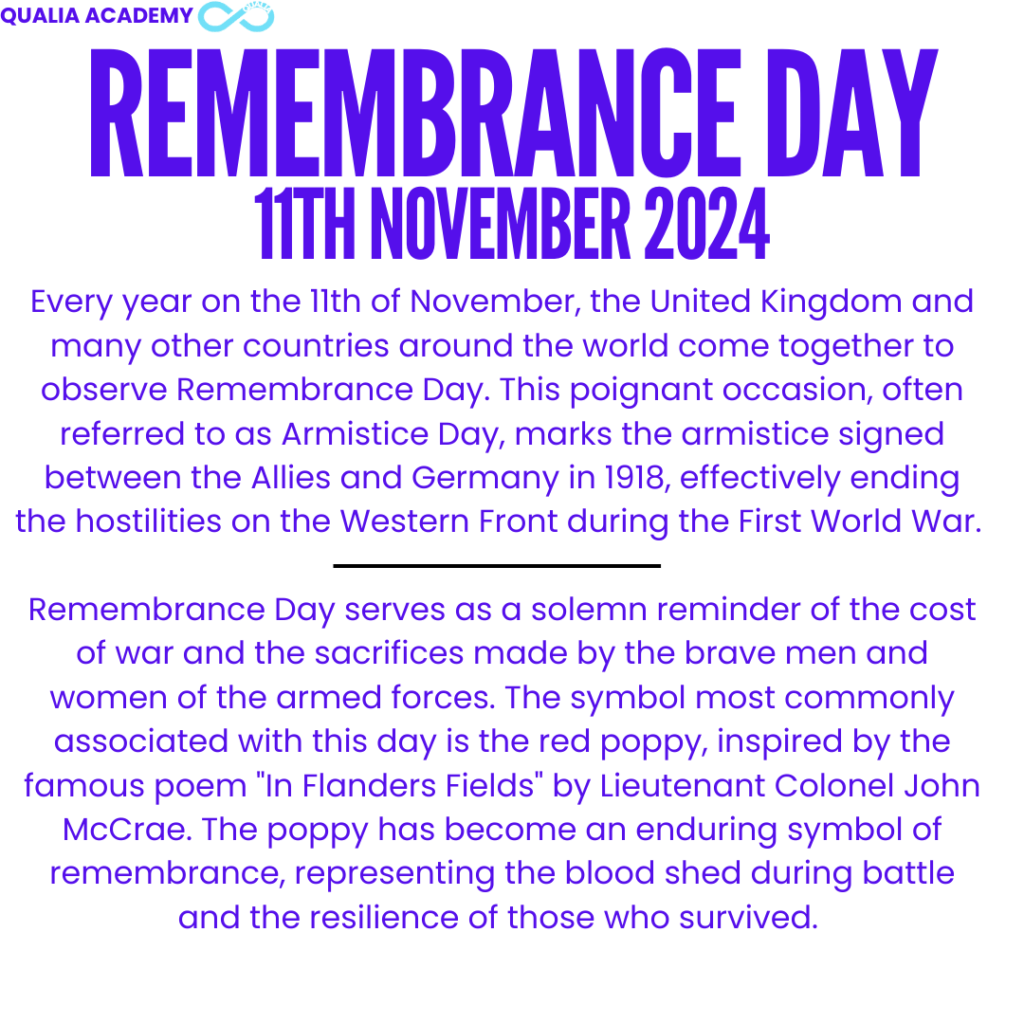
Every year on the 11th of November, the United Kingdom and many other countries around the world come together to observe Remembrance Day. This poignant occasion, often referred to as Armistice Day, marks the armistice signed between the Allies and Germany in 1918, effectively ending the hostilities on the Western Front during the First World War. However, the day has evolved into a broader commemoration, honouring all those who have served and sacrificed their lives in the line of duty, across conflicts spanning generations.
The Significance of Remembrance Day
Remembrance Day serves as a solemn reminder of the cost of war and the sacrifices made by the brave men and women of the armed forces. The symbol most commonly associated with this day is the red poppy, inspired by the famous poem “In Flanders Fields” by Lieutenant Colonel John McCrae. The poppy has become an enduring symbol of remembrance, representing the blood shed during battle and the resilience of those who survived.
On Remembrance Day, we reflect not only on the losses of the First World War but also on the sacrifices made in subsequent conflicts, including the Second World War, the Korean War, the Gulf War, and contemporary missions in Iraq and Afghanistan. This day is not merely a historical reflection; it also serves to foster a sense of gratitude and recognition for the sacrifices of our veterans.
Observing Remembrance Day
The day begins with a two-minute silence at 11 a.m., marking the precise moment when the armistice came into effect. This silence is a powerful act of remembrance, allowing individuals and communities to pause and reflect on the lives lost and the bravery displayed by those in the armed forces. Across the UK, public ceremonies are held at war memorials, where veterans, dignitaries, and members of the public gather to pay their respects.
In London, the annual Remembrance Day service takes place at the Cenotaph, a national war memorial located in Whitehall. The event is attended by members of the royal family, government officials, and veterans, all of whom lay wreaths at the base of the Cenotaph. The Queen or King of the United Kingdom traditionally leads the ceremony, underscoring the day’s importance to the nation.
The Role of Poppies
The Royal British Legion plays a significant role in the Remembrance Day commemorations. Each year, they produce millions of poppies that are distributed across the UK. The funds raised from poppy sales are vital in providing support for veterans and their families, offering services such as housing, rehabilitation, and mental health care. Wearing a poppy not only shows respect for those who have served but also contributes to the ongoing welfare of the armed forces community.
The design of the poppy itself has evolved over the years. Initially, the poppies were made from paper; however, today they are often crafted from fabric and are available in various colours to represent different causes. The red poppy remains the most recognised symbol, but white poppies are worn to signify a call for peace, while purple poppies commemorate the animals that served alongside soldiers.
Remembering Beyond the Day
While Remembrance Day is a pivotal moment in our national calendar, it is essential to remember our heroes throughout the year. The sacrifices made by service members do not fade with time, and the impacts of war are felt long after the last shots are fired. By engaging with veterans and understanding their experiences, we can foster a culture of respect and recognition.
Many organisations throughout the UK work tirelessly to support veterans, providing opportunities for employment, social engagement, and mental health support. Volunteering for these organisations or attending local events can be a powerful way to honour our servicemen and women, ensuring their sacrifices are not forgotten.
Education and Awareness
Education plays a pivotal role in ensuring that the sacrifices made by service members are not forgotten and that the lessons of history continue to resonate with future generations. Across the UK, schools actively engage students in discussions about Remembrance Day, the impact of wars, and the importance of peace, fostering a sense of understanding and respect.
Incorporating Remembrance Day into the Curriculum
Many educators take the opportunity to incorporate Remembrance Day into their history curriculum, discussing not only the events of the First and Second World Wars but also examining more recent conflicts, such as those in Iraq and Afghanistan. By providing a comprehensive overview of the historical context, students can better understand the complexities of warfare, the reasons behind conflicts, and the human cost associated with them.
Engaging Activities and Projects
Schools often organise various engaging activities and projects that allow students to actively participate in the remembrance process:
Creative Writing and Poetry
Students might be encouraged to write poems or essays reflecting on the experiences of soldiers or the themes of bravery, sacrifice, and peace. These creative works can foster empathy and understanding of the emotional toll of war.
Art Projects
Art classes may incorporate the creation of poppy-themed artwork, allowing students to express their feelings about remembrance visually. Some schools even organise exhibitions showcasing these pieces, inviting the community to engage with the theme of remembrance through art.
School Assemblies and Community Involvement
Assemblies held around Remembrance Day often feature guest speakers, such as veterans or representatives from local military organisations, who can share their experiences and insights with students. Hearing firsthand accounts can profoundly impact students, allowing them to appreciate the reality of military service and the sacrifices made by individuals.
Involving the local community is another effective strategy. Schools can collaborate with local war memorials or community centres to organise events that bring students, families, and veterans together. These community events not only enhance the educational experience but also foster intergenerational dialogue, bridging the gap between younger and older generations.
Visiting Memorials and Historical Sites
Field trips to local war memorials, museums, or historical sites related to military history can offer students a visceral understanding of the themes surrounding Remembrance Day. Such visits allow students to engage directly with history, providing context to their studies. Many museums offer tailored educational programmes specifically designed for school groups, including guided tours that highlight the significance of various exhibits related to wartime experiences.









